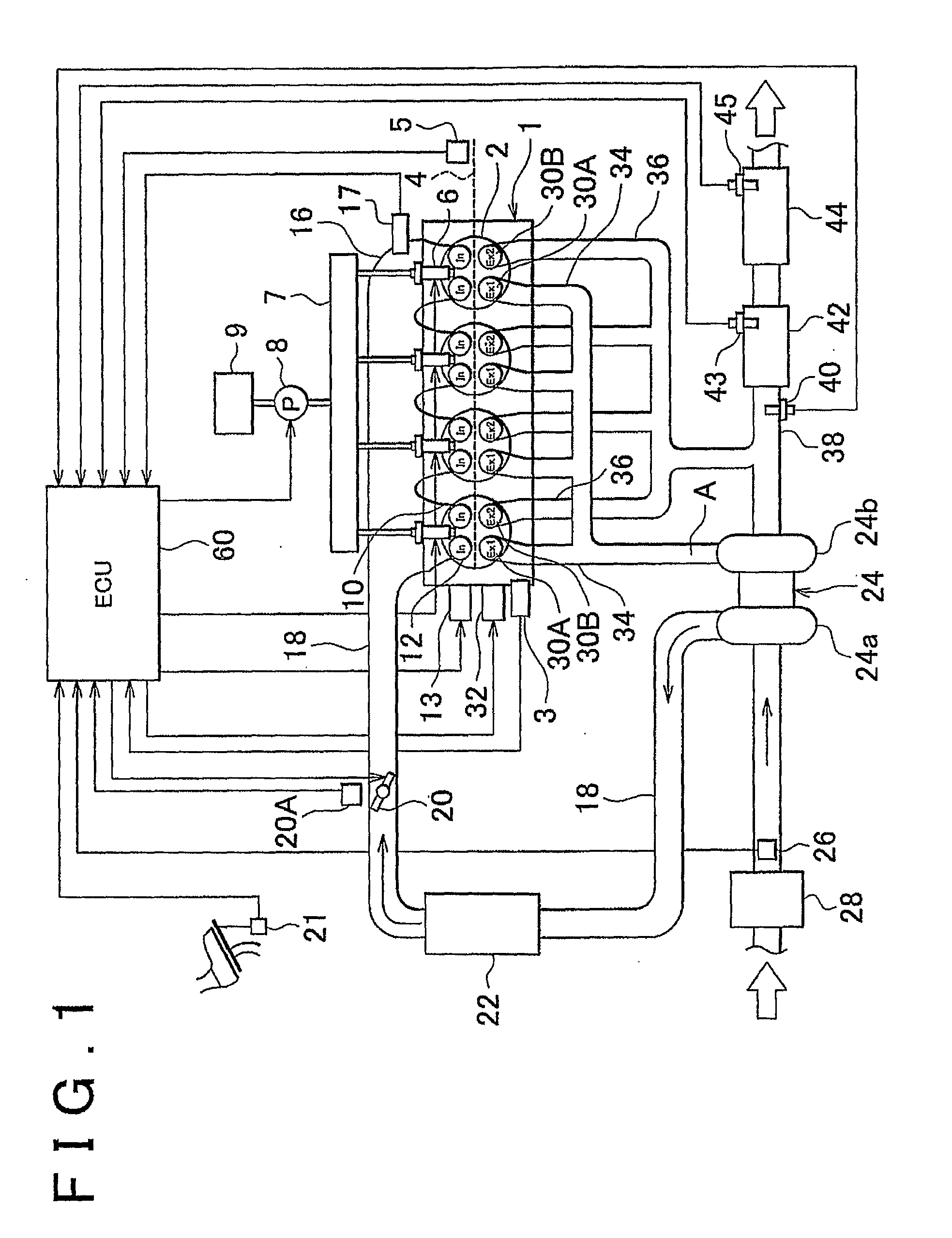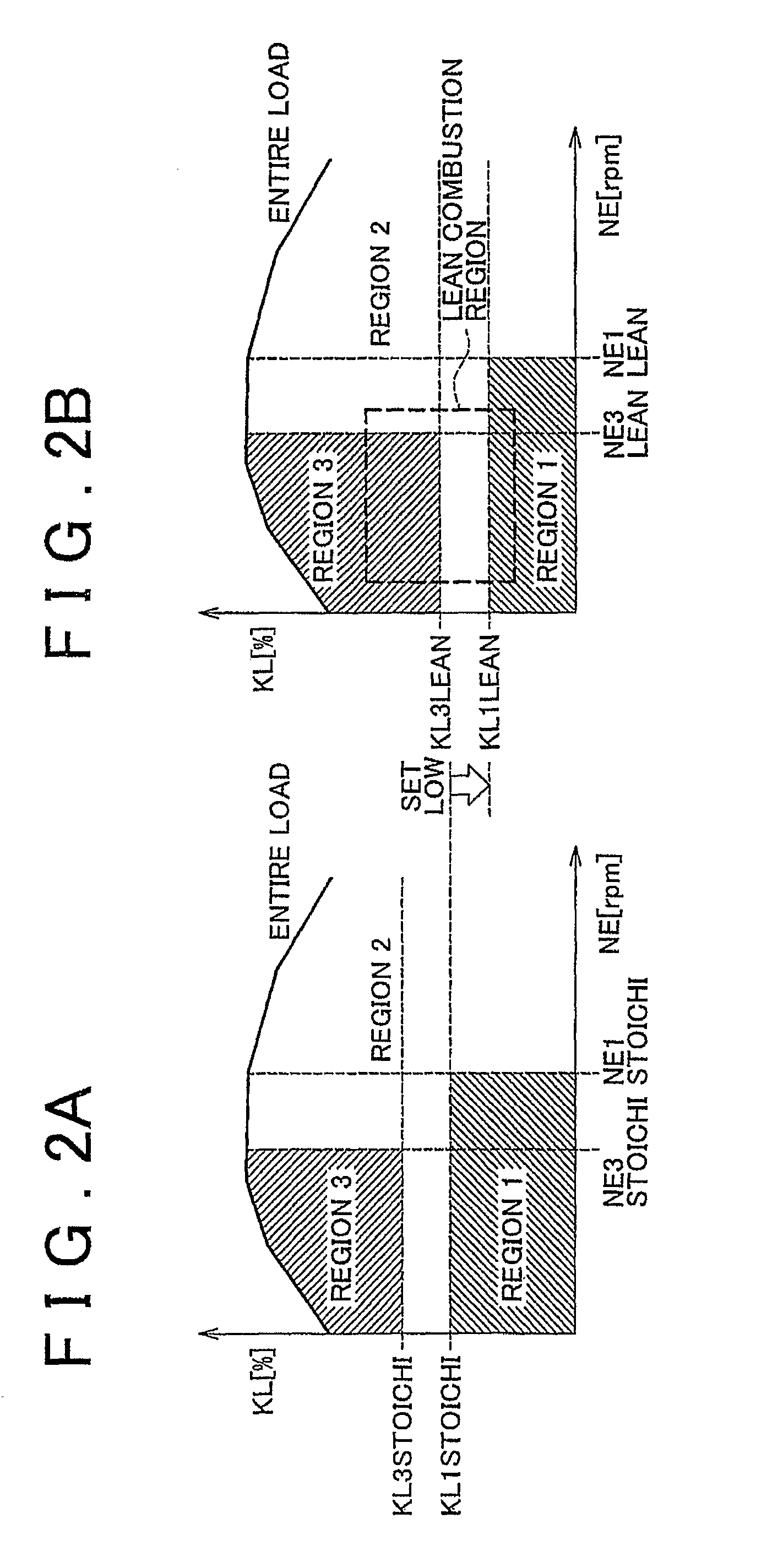Control device and control method for internal combustion engine
a control device and control method technology, applied in the direction of electric control, machines/engines, output power, etc., can solve the problems of likely deterioration of the response of the turbocharger, and achieve the effects of preventing the rich shift of air-fuel ratio, sufficient exhaust energy, and sufficient charging pressur
- Summary
- Abstract
- Description
- Claims
- Application Information
AI Technical Summary
Benefits of technology
Problems solved by technology
Method used
Image
Examples
embodiment 1
Concrete Processes in Embodiment 1
[0072]FIG. 4 is a flowchart showing a process that the ECU 60 executes in Embodiment 1. This process is started at a predetermined timing before the exhaust valves Ex1, Ex2 are driven. According to the process shown in FIG. 4, the engine rotation speed NE and the engine load KL are firstly read (step 100). Subsequently, the engine operation mode is referred to on the basis of the engine rotation speed NE and the engine load KL read in step 100 (step 102). It is to be noted herein that, in a process other than the present process, one of the stoichiometric combustion and the lean combustion is determined as the engine operation mode to be executed, on the basis of the engine rotation speed NE and the engine load KL. In the foregoing step 102, the thus-determined engine operation mode is referred to.
[0073]After that, it is determined whether or not the engine operation mode referred to in step 102 is the lean combustion or the rich spike control is be...
embodiment 2
Concrete Processes in Embodiment 2
[0093]FIG. 7 is a flowchart showing a process that the ECU 60 executes in Embodiment 2. This process is started at a predetermined timing before the exhaust valves Ex1, Ex2 are driven.
[0094]According to the process shown in FIG. 7, the process of steps 100 to 104 is firstly executed as in the process shown in FIG. 4. if in step 104 it is determined that the present engine operation mode is the stoichiometric combustion; NE1=NE1STOICHI and KL1=KL1STOICHI are calculated (step 110) as in the process shown in FIG. 4. After that, NE3=NE3STOICHI and KL3=KL3STOICHI are calculated (step 112).
[0095]On the other hand, if in step 104 it is determined that the present engine operation mode is the lean combustion or the rich spike control is being executed, the ECU 60 acquires the pre-catalyst bed temperature Tp and the NOx catalyst bed temperature Tnox (step 130), unlike the process shown in FIG. 4. After that, it is determined whether or not the pre-catalyst b...
embodiment 3
Concrete Processes of Embodiment 3
[0108]FIG. 11 is a flowchart showing a process that the ECU 60 executes in Embodiment 3. This process is started at a predetermined timing before the exhaust valves Ex1, Ex2 are driven.
[0109]According to the process shown in FIG. 11, the engine rotation speed NE and the engine load KL are read (step 100), and the engine operation mode is referred to (step 102), as in the process shown in FIG. 4. After that, it is determined whether or not the engine operation mode referred to in step 102 is the lean combustion (step 140). If in step 140 it is determined that the present engine operation mode is the stoichiometric combustion, the process is ended.
[0110]On the other hand, if in step 140 it is determined that the engine operation mode is the lean combustion, the pre-catalyst bed temperature Tp and the NOx catalyst bed temperature Tnox are acquired (step 130), as in the routine shown in FIG. 6. After that, it is determined whether or not the pre-catalys...
PUM
 Login to View More
Login to View More Abstract
Description
Claims
Application Information
 Login to View More
Login to View More - R&D
- Intellectual Property
- Life Sciences
- Materials
- Tech Scout
- Unparalleled Data Quality
- Higher Quality Content
- 60% Fewer Hallucinations
Browse by: Latest US Patents, China's latest patents, Technical Efficacy Thesaurus, Application Domain, Technology Topic, Popular Technical Reports.
© 2025 PatSnap. All rights reserved.Legal|Privacy policy|Modern Slavery Act Transparency Statement|Sitemap|About US| Contact US: help@patsnap.com



